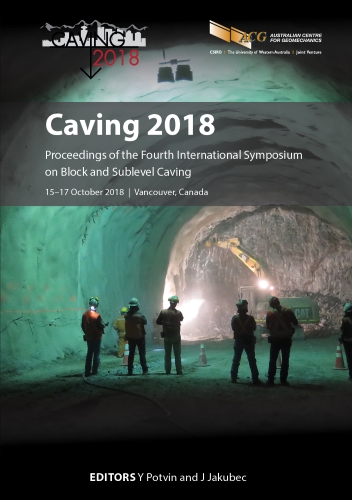Evaluating the effect on seismicity of a hydraulic fracturing trial using Bayesian data analysis

|
Authors: Jonsson, K; Martinsson, J |
DOI https://doi.org/10.36487/ACG_rep/1815_50_Jonsson
Cite As:
Jonsson, K & Martinsson, J 2018, 'Evaluating the effect on seismicity of a hydraulic fracturing trial using Bayesian data analysis', in Y Potvin & J Jakubec (eds), Caving 2018: Proceedings of the Fourth International Symposium on Block and Sublevel Caving, Australian Centre for Geomechanics, Perth, pp. 451-658, https://doi.org/10.36487/ACG_rep/1815_50_Jonsson
Abstract:
During the summer of 2017, a hydraulic fracturing trial was performed in the crown pillar of one of the orebodies in LKAB’s mine in Malmberget. Mucking in the orebody beneath the crown pillar recommenced in September 2017, after being shut down since April 2015. The mucking was shut down in 2015 because a number of large seismic events had caused significant disturbances in the nearby town, with vibration up to 35 mm/s. A research project was started with the final goal to start up production again with less disturbance to the town. Hydraulic fracturing was determined to be an interesting method for improving caveability of the crown pillar, and a trial was set up. The trial consisted of partially fracturing three boreholes drilled from the ground surface into the crown pillar, which is between 550 and 650 m thick at the trial location. Hydraulic fractures were placed with 2.5 m spacing at the bottom 50 m of each hole. As part of the evaluation of the effectiveness of the trial, the seismicity before and after the hydraulic fracturing trial has been compared using standard Bayesian techniques to infer differences. The analysis show a difference in b-value before and after the trial, which is demonstrated by the parameter 𝛥b having a positive value. The 95% high density interval (HDI) of 𝛥b excludes the value of zero, which gives confidence in the conclusion. The difference in b-value depends on the choice of magnitude of completeness, so it is recommended that the analysis is repeated with a method using all recorded events, i.e. using the full dataset.
Keywords: hydraulic fracturing, seismicity, Bayesian data analysis
References:
Harris, PC & Wesseloo, J 2015, mXrap, computer software, Australian Centre for Geomechanics, The University of Western Australia, Perth, https://www.mXrap.com
Kruschke, JK 2015, Doing Bayesian Data Analysis: A Tutorial with R, JAGS, and Stan, 2nd edn, Academic Press, Cambridge.
Lowther, RJ, Olivier, L, Lett, JL & Brunton, I 2016, ‘Implementation of a surface-based hydraulic fracturing program to successfully propagate a large cave through hard, competent near-surface rock masses to achieve breakthrough’, Proceedings of MassMin 2016, The Australasian Institute of Mining and Metallurgy, Melbourne, pp. 83–95.
Martinsson, J & Jonsson, A 2018, ‘A new model for the distribution of observable earthquake magnitudes and application to b-value estimation’, IEEE Geoscience and Remote Sensing Letters, vol. 15, no. 6,
PyStan 2018, PyStan, computer software, https://pystan.readthedocs.io/en/latest/index.html
Stan 2018, Stan, computer software, http://mc-stan.org
© Copyright 2025, Australian Centre for Geomechanics (ACG), The University of Western Australia. All rights reserved.
View copyright/legal information
Please direct any queries or error reports to repository-acg@uwa.edu.au
View copyright/legal information
Please direct any queries or error reports to repository-acg@uwa.edu.au
